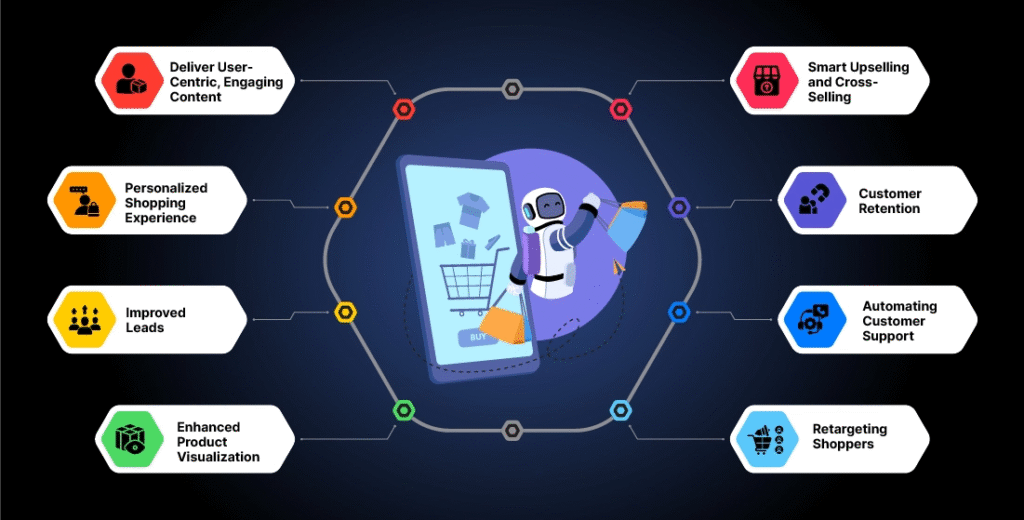In the past decade, e-commerce has reshaped the way people buy and sell goods across the world. But now, a new wave of transformation is unfolding—powered by Artificial Intelligence (AI). From personalized product recommendations to automated customer service and dynamic pricing, AI is revolutionizing every aspect of online shopping.
Let’s dive deep into how AI is changing the landscape of e-commerce, what technologies are driving this shift, and how businesses—and consumers—are benefitting from this intelligent evolution.
🌐 1. The Evolution of E-commerce: From Clicks to Intelligence
The story of e-commerce began in the mid-1990s when companies like Amazon and eBay introduced the concept of buying online. Back then, websites were static, with limited personalization and manual updates. Fast forward to today, e-commerce is smart, dynamic, and adaptive—all thanks to Artificial Intelligence.
AI isn’t just a buzzword anymore; it’s the backbone of modern e-commerce. It helps businesses understand their customers better, predict trends, and optimize operations in ways that were once impossible.
🤖 2. What Exactly is AI-Driven E-commerce?
AI-driven e-commerce refers to the integration of Artificial Intelligence tools and algorithms into online retail operations. These tools help automate decisions, provide personalized experiences, and analyze massive datasets in real time.
In simple terms, AI helps online stores act like a human sales assistant—one who knows what you like, when you like it, and how much you’re willing to pay.
Example: When you browse Amazon and see “Recommended for You” products or when Netflix suggests a movie based on your viewing habits—that’s AI in action.
📈 3. Why AI is a Game-Changer for Online Shopping
The use of AI in e-commerce has transformed not only how businesses sell but also how customers shop. Here’s why AI is a true game-changer:
-
Personalization: AI analyzes browsing history, purchase behavior, and demographics to create unique shopping experiences.
-
Efficiency: Automated tools handle customer queries, inventory, and logistics.
-
Prediction: AI predicts what products will be in demand and at what price.
-
Customer Retention: AI-powered insights help businesses understand what keeps customers coming back.
🧠 4. Core Technologies Behind AI-Driven E-commerce
| Technology | Description | Use Case in E-commerce |
|---|---|---|
| Machine Learning (ML) | Algorithms that learn from data and improve over time. | Personalized recommendations, fraud detection. |
| Natural Language Processing (NLP) | Enables computers to understand human language. | Chatbots, sentiment analysis. |
| Computer Vision | Helps systems interpret visual information from images and videos. | Virtual try-ons, product tagging. |
| Predictive Analytics | Uses historical data to forecast trends and behavior. | Demand forecasting, inventory planning. |
| Robotic Process Automation (RPA) | Automates repetitive business processes. | Order processing, invoice generation. |
These technologies work together to make the shopping journey faster, smarter, and more human-like.
🛒 5. Personalized Shopping: AI’s Secret Sauce
One of the biggest advantages of AI in e-commerce is personalization. Traditional marketing treated all customers alike—but AI makes it possible to treat every individual uniquely.
AI analyzes:
-
Search behavior
-
Past purchases
-
Time spent on certain products
-
Abandoned cart data
-
Device and location
This data helps in creating personalized product suggestions and targeted ads.
Example:
When you look at a pair of sneakers online and start seeing similar styles in ads across social media or Google—that’s AI-powered retargeting.
Impact: Studies show that personalization can boost e-commerce sales by up to 20–30% and improve customer loyalty dramatically.
💬 6. AI Chatbots: The 24/7 Virtual Sales Assistants
Customer service is a key element of online shopping. AI chatbots have become the new front-line representatives for many e-commerce stores.
These bots can:
-
Answer FAQs
-
Track orders
-
Suggest products
-
Process returns
-
Handle payments
Unlike human agents, AI bots are available 24/7, respond instantly, and learn with every interaction.
Example:
When you message a store on WhatsApp or its website and get an instant reply saying, “Hi there! How can I help you today?”—that’s AI-driven conversational commerce in action.
Future Trend:
AI chatbots are evolving to handle emotional tone recognition and voice-based interactions for a more natural experience.
📦 7. Smart Inventory and Supply Chain Optimization
AI is helping e-commerce companies manage their supply chains with incredible precision. Predictive analytics allows retailers to anticipate demand, preventing both overstocking and understocking.
Key Advantages:
-
Predicts which products will sell faster.
-
Automates warehouse restocking.
-
Reduces logistics costs through route optimization.
Example:
Amazon uses robots and AI algorithms to manage its fulfillment centers, predicting which items need to be close to which customers for faster delivery.
💸 8. Dynamic Pricing: AI Knows What You’ll Pay
Have you ever noticed that the price of a flight or a product changes when you search multiple times? That’s AI-driven dynamic pricing in play.
AI analyzes factors like:
-
Demand and supply
-
Competitor pricing
-
Customer purchase patterns
-
Seasonal trends
Then, it adjusts prices in real time to maximize profit while still staying competitive.
Impact:
Dynamic pricing can increase revenue by 10–15% while improving conversion rates.
📊 9. Visual Search and Voice Commerce
AI has enabled new ways of shopping beyond typing keywords.
Visual Search
Customers can upload an image, and AI finds similar products.
Example: Pinterest Lens and Google Lens let users search visually instead of textually.
Voice Commerce
Smart assistants like Alexa, Siri, and Google Assistant are powering voice-based shopping.
Example:
You can now say, “Alexa, reorder my last purchase of coffee,” and the system takes care of it instantly.
Voice commerce is expected to become a $30 billion market globally in the coming years.
🔍 10. AI in Marketing: Smarter Campaigns, Better Results
Marketing is where AI truly shines. With access to real-time data, AI tools can:
-
Identify the best time to send promotions
-
Segment customers precisely
-
Optimize ad spending
-
Predict churn and retention
Example:
AI tools like Google Ads Smart Bidding and Meta’s Advantage+ campaigns automatically adjust ad delivery for maximum ROI.
Result:
Businesses report up to 40% higher engagement and lower marketing costs when using AI-driven strategies.
🧩 11. Fraud Detection and Cybersecurity
E-commerce fraud is a major issue—but AI offers a strong defense. Machine learning algorithms can detect unusual patterns, flag suspicious transactions, and block fake reviews or bots.
AI Security Features:
-
Real-time transaction monitoring
-
Identity verification using biometrics
-
Fraud pattern recognition
Example:
PayPal uses AI to analyze millions of transactions per day and detect fraudulent behavior instantly.
🌍 12. AI and Sustainability in E-commerce
Sustainability is now a business priority. AI contributes by:
-
Reducing waste through accurate demand forecasting
-
Optimizing delivery routes to cut carbon emissions
-
Encouraging eco-friendly shopping behavior
Example:
AI systems suggest energy-efficient packaging and promote sustainable products to customers with eco-conscious preferences.
📦 13. The Future of AI in E-commerce: What’s Next?
The evolution of AI in e-commerce is just beginning. Over the next few years, we’ll see the integration of advanced technologies like:
-
Generative AI: For automated product descriptions and visual designs.
-
Augmented Reality (AR): Virtual try-ons for clothes and accessories.
-
Predictive Personalization: Systems that predict what customers will want before they even know it.
-
AI Shopping Avatars: Personal digital assistants that handle your entire shopping process automatically.
Imagine saying, “Find me the best phone under ₹30,000 with great camera quality,” and your AI assistant compares thousands of options and completes the purchase in seconds. That’s the near future of online shopping.
📉 14. Challenges of AI in E-commerce
Despite its benefits, AI brings certain challenges:
| Challenge | Explanation | Possible Solution |
|---|---|---|
| Data Privacy | Customers worry about how their data is used. | Transparent policies, data encryption. |
| Implementation Cost | AI tools are expensive for small businesses. | Scalable SaaS-based AI solutions. |
| Algorithm Bias | Biased data can lead to unfair recommendations. | Regular audits and diverse datasets. |
| Customer Trust | Too much automation may feel impersonal. | Balance AI with human interaction. |
Addressing these issues is key to making AI truly customer-centric and ethical.
🧭 15. Case Studies: How Top Brands Use AI
| Brand | AI Use Case | Impact |
|---|---|---|
| Amazon | Personalized recommendations, logistics optimization. | Increased sales, reduced delivery time. |
| Sephora | Virtual makeup try-on via computer vision. | Improved customer engagement. |
| Nike | AI-powered predictive demand and product customization. | Better inventory management. |
| Alibaba | Smart logistics, chatbots, and virtual fitting rooms. | Enhanced user experience. |
These examples show how deeply AI has already embedded itself in the DNA of successful e-commerce operations.
💡 16. How Small Businesses Can Leverage AI
AI isn’t just for giants like Amazon or Alibaba. Small and medium-sized online stores can also benefit.
Practical Ways to Use AI:
-
Use AI chatbots for customer service (like ManyChat or Tidio).
-
Implement recommendation engines (like Nosto or Clerk.io).
-
Analyze customer behavior using Google Analytics AI insights.
-
Automate marketing campaigns with AI-based tools (like HubSpot).
Even basic automation can improve customer satisfaction and save hours of manual work each week.
🔮 17. The Human Touch in an AI World
While AI automates many processes, the human element still matters. Customers value empathy, storytelling, and trust—qualities that AI can’t fully replicate yet.
The best e-commerce brands blend AI efficiency with human creativity. For example:
-
Use AI for insights, but humans for creative content.
-
Let AI handle data, while humans build emotional connections.
This hybrid model ensures technology empowers, not replaces, human intelligence.
🧾 18. Key Takeaways
| Aspect | Impact of AI |
|---|---|
| Customer Experience | Personalized, faster, and more engaging. |
| Business Operations | Efficient, automated, and predictive. |
| Marketing | Smarter targeting and ROI optimization. |
| Security | Advanced fraud prevention and trust-building. |
| Future Potential | Integration with AR, VR, and generative AI. |
AI isn’t replacing e-commerce—it’s redefining it.
🚀 19. Conclusion: The Intelligent Future of Shopping
The rise of AI-driven e-commerce is not just a technological shift; it’s a revolution in human behavior. We are moving from searching for products to having them find us.
AI has made shopping intuitive, predictive, and enjoyable. From the moment a customer lands on a website to the instant their package arrives, AI plays a role in shaping the journey.
As AI continues to evolve, the line between physical and digital retail will blur even further—ushering in a new era where every click, scroll, and purchase is intelligently personalized.


